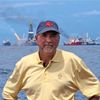Yesterday, under intense questioning from the attorney for blowout preventer (BOP) manufacturer Cameron International, the project manager for Det Norske Veritas (DNV), the company who led the investigation of the BOP, admitted an error in the computer model they used to determine the cause of failure of the BOP during the BP well blowout last April. The admission came during testimony on the first day of hearings convened in Metairie, Louisiana, by the board of the Joint Investigation of the Deepwater Horizon disaster to gather evidence about the forensics report on the BOP.
Even before testimony began, Cameron's attorney David Jones stated:
"The report by Det Norske Veritas is based on a single hypothesis. That hypothesis is based not on testing but on computer models. The data that supports those computer models not included in the report. We requested the backup data on March 25."
As he questioned Neil Thompson, as well as lead investigator, Greg Kenney, several weaknesses and mistakes in the DNV report were revealed including:
- DNV used only computer modeling, not actual testing of the blind shear ram to determine that drill pipe deflected to the side of the ram bore, jamming the ram block.
- The computer model placed the drill pipe in the wrong place in the ram bore.
- None of the pipe recovered from the BOP was actually bent or buckled. The witnesses said that they assumed the pipe was "elastic" and return to its original shape after recovery.
- Even though testimony from Transocean employees on the rig stated that the upper annular was opened before the blowout, and it was open when they received it, the investigators assumed that the annular was closed. (This has always been a question for me, since subsea supervisor Chris Pleasant testified early on that the upper annular had been closed at the time of the blowout and that the crew actually held additional pressure on it to keep it from leaking. Testimony from others that it was open during displacement of the riser conflicts, in my view, with this recollection.)
- Not all functions of the BOP were tested.
Again, key witnesses from Transocean have refused to testify before the board even after BOEMRE director Michael Bromwich pressured the company to compel them to do so. Even though remaining silent is certainly their right, we won't really know what happened until we get this key information.
I'm afraid that this testimony has the effect of the ol' one step forward and two steps back. Cameron has revealed critical mistakes in the DNV study, and at least one government agency, the Chemical Safety Board, has impllied that more study is needed before we will really know what happened. Yet, with all these huge question marks, we are still going back to work in the deepwater. Was it design? Poor maintenance? Merely a "black swan"? These are critical questions that have not been answered and workers' lives and the environment hang in the balance.
Just a note: The raging apathy and silence from the media on this issue is deafening. The hearings are not being live streamed by anyone, including C-Span, and the only news outlets covering what are probably the most important of these critical hearings is the Times-Picayune out of New Orleans and my pals over at the Houston Chronicle's Fuel Fix. All else is dead silence. I'm amazed.
Bob Cavnar, a 30-year veteran of the oil and gas industry, is the author of Disaster on the Horizon: High Stakes, High Risks, and the Story Behind the Deepwater Well Blowout. He is CEO of Luca Technologies.
